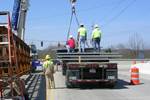AIT Bridges ships first composite bridge system to the West Coast
Comprised of 12 fiberglass composite arches, the bridge was spliced, transported and reassembled on-site, expediting the building process.

Source | AIT Bridges
AIT Bridges, a division of Advanced Infrastructure Technologies (AIT; Brewer, Maine, U.S.), a designer and supplier of composite bridge systems and structural components for commercial construction, announced on August 18 that it has delivered the first composite arch bridge system to the West Coast, on SR 203 in Duvall, Washington. However, its construction alone, says the company, marks several important milestones.
According to AIT Bridges, the bridge is comprised of 12 fiberglass composite arches manufactured at its Brewer, Maine facility. To facilitate cross-country shipping, the bridge’s arches, which span 51 feet, were cut in half. Moreover, the bridge required no transportation permits due to its ability to be cut and then reassembled on-site.
The bridge will also indirectly help facilitate the restoration of the stream that it traverses. The stream under the previous bridge, which was approximately five feet wide, will now be widened and restored to its previous 20-foot width to accommodate the return of fish and other wildlife to the area.
Developed in cooperation with The University of Maine’s Advanced Structures and Composites Center, AIT Bridges’ product offerings have been commercially available and installed since 2010. Its composite arch bridge system uses concrete-filled composite tubes and FRP decking, which AIT Bridges says provides an affordable and superior alternative to traditional steel and concrete small-to medium-sized bridges.
“It took some planning to achieve the transportation and assembly of the first composite bridge system to the West Coast. We saved time and money by splicing the bridge arches as they were trucked across the country. No permits, no road closures and now that the materials are on-site, we are looking at an expedited bridge building process,” says Ken Sweeney, president and chief engineer, AIT Bridges. “This bridge is also ushering in a new era for the stream it crosses. Wildlife restoration is an important “perk” of this particular project. We look forward to seeing the completed span open for traffic this fall.”
The bridge’s construction is expected to be completed in September 2020.
Related Content
-
Materials & Processes: Composites fibers and resins
Compared to legacy materials like steel, aluminum, iron and titanium, composites are still coming of age, and only just now are being better understood by design and manufacturing engineers. However, composites’ physical properties — combined with unbeatable light weight — make them undeniably attractive.
-
The making of carbon fiber
A look at the process by which precursor becomes carbon fiber through a careful (and mostly proprietary) manipulation of temperature and tension.
-
Materials & Processes: Resin matrices for composites
The matrix binds the fiber reinforcement, gives the composite component its shape and determines its surface quality. A composite matrix may be a polymer, ceramic, metal or carbon. Here’s a guide to selection.













.jpg;maxWidth=300;quality=90)


